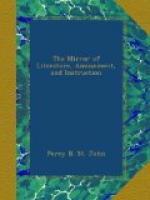“The town within the wall,” says Sir W. Gell, “is like all those in this part of the world, encumbered with the fallen ruins of former habitations. These have been generally constructed by the Turks, since the expulsion of the Venetians; for it appears, that till the long continued habit of possession had induced the Mahometans to live upon and cultivate their estates in the country, and the power of the Venetian republic had been consumed by a protracted peace, a law was enforced which compelled every Turk to have a habitation in some one of the fortresses of the country. But the habitatations,” says our traveller, “present generally an indiscriminate mass of ruins; they were originally erected in haste, and being often cemented with mud instead of mortar, the rains of autumn, penetrating between the outer and inner faces of the walls, swell the earth, and soon effect the ruin of the whole”—it must be confessed, but sorry structures for the triple fires of an enemy. Sir William, on his visit, found the commandant in a state of misery not exceeded by the lot of his meanest fellow-citizens, except that his robes were somewhat in better condition. He received him “very kindly in a dirty unfurnished apartment,” into which he “climbed by a tottering ladder from a court strewed with ruins;” here he gave him “coffee,” after which he took his leave. What would a first lord of the Admiralty say to such a reception? and it must have been somewhat uncourtly to our traveller.
The soil about Navarino is of a red colour, and is remarkable for the production of an infinite quantity of squills, which are used in medicine. The rocks, which show themselves in every direction through a scanty but rich soil, are limestone, and present a general appearance of unproductiveness round the castle of Navarino; and the absence of trees is ill compensated by the profusion of sage, brooms, cistus, and other shrubs which start from the innumerable cavities of the limestone.
The remains of Navarino Vecchio, or ancient Navarino, consist in a fort or castle of mean construction, covering the summit of a hill sloping quickly to the south, but falling in abrupt precipices to the north and east. The town was built on the southern declivity, and was surrounded by a wall, which, allowing for the natural irregularities of the soil, represented a triangle, with the castle at the apex or summit—a form observable in many of the ancient cities of Greece.
The foundation of the walls throughout the whole circuit remains entire; but the fortifications were never of any consequence, though they present a picturesque group of turrets and battlements from below, and must have been very imposing from the sea,—an effect which those of the modern city have recently failed to produce. From the top is an extensive view over the island of Sphacteria, the port, with the town of Navarino to the south, and a considerable tract of the territory anciently called Messenia on




